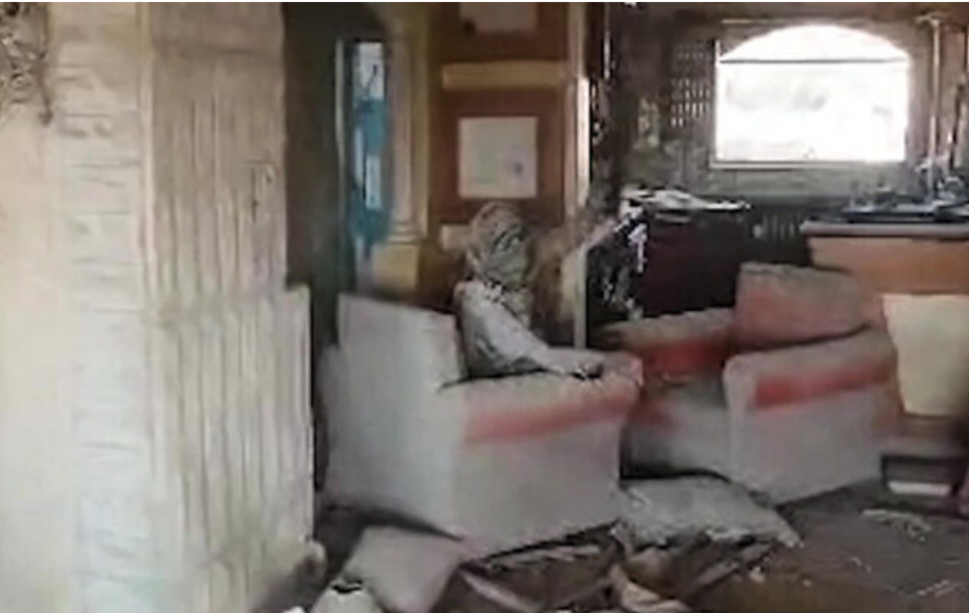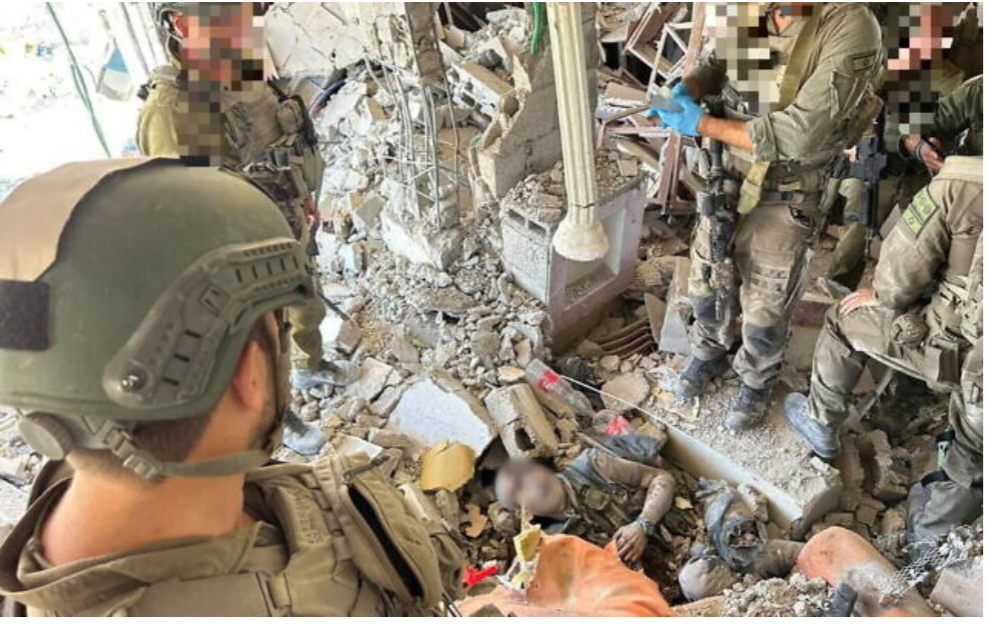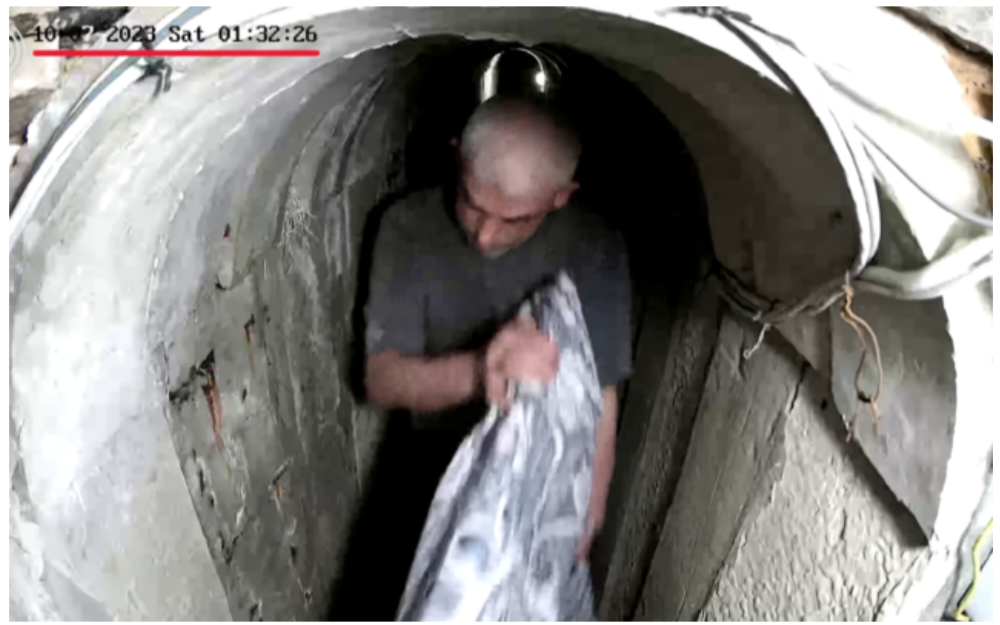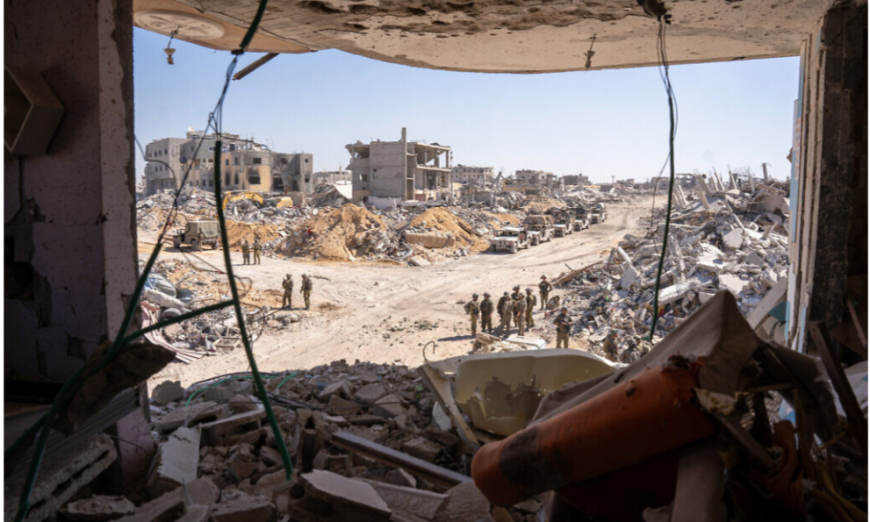View from the spot where Hamas leader Yahya Sinwar was killed by IDF troops on October 16, 2024, on the second floor of a house in the Tel Sultan neighborhood of Rafah, southern Gaza, October 20, 2024. (Emanuel Fabian).
Vigilant soldiers of Col. Sivan Bloch’s brigade tracked down and killed Hamas chief and his guards after spotting suspicious movement, and before knowing their identities.
RAFAH, Gaza Strip — Standing outside the building where the leader of Hamas and architect of the October 7 onslaught met his end days earlier, Col. Sivan Bloch stressed on Sunday that the elimination of Yahya Sinwar by a patrol under his command, in what has been widely reported as a chance encounter, was “not a stroke of luck.”
Bloch, who commands the Israel Defense Force’s 828th Brigade, known as Bislamach — or the School for Infantry Corps Professions and Squad Commanders during peacetime — had recently begun operations in Rafah after the military announced it had defeated Hamas’s organized fighting force there. The Bislamach Brigade was tasked with continuing mop-up operations in Rafah, including locating and demolishing leftover Hamas infrastructure, eliminating members of the terror group, and searching for signs of hostages.
On Wednesday, as the troops operated in Rafah’s northwestern Tel Sultan neighborhood, a vigilant soldier stationed in an ambush spotted suspicious movement several hundred meters away. The incident was almost given an all-clear after nothing was initially found, but trackers with the brigade searched the area and found fresh footprints on the ground, Bloch told reporters here on Sunday morning.
The trackers and other troops followed the footprints to a house in the area, where they heard voices, later revealed to have been those of Sinwar and his guards, among them the commander of Hamas’s Tel Sultan Battalion, Mahmoud Hamdan.
“The squad got stressed out by the soldiers who engaged them, and fled,” Bloch said, pointing to another nearby building where at least four of the suspects, including Sinwar, ran to. “This is where the first engagement was.”
According to Bloch, after his soldiers and officers, including the commander of his 450th Battalion, opened fire on the cell of terror operatives, they fled again.

The house where Hamas leader Yahya Sinwar was killed by troops, in southern Gaza’s Rafah, October 20, 2024. (Emanuel Fabian.)
“From this engagement, they fled; they didn’t fight or anything. The battalion commander and the soldiers managed to hit some of them. And from here, they dispersed. Sinwar ran to the house behind me, another terrorist fled to that house, and two others in that direction,” the brigade commander recalled at the scene. Moments later, the soldiers exchanged fire with some of the gunmen, who fled in different directions. One soldier was wounded in the exchanges.
Not long after that, an officer spotted fresh drops of blood leading into the house where Sinwar was hiding. It was later revealed that Sinwar had been wounded in the arm when hit by the battalion commander during the first engagement.
At that moment, Sinwar hurled two grenades down the stairs from the second floor of the house at the troops, one of which exploded. The soldiers were unharmed as they were already withdrawing from the building after realizing a terror operative was inside.
A small IDF drone then flew in to search the room, and found a man with his arm injured and his face covered.
The man threw a wooden stick at the drone, in a failed attempt to knock it down.

This screenshot from a handout video released by the IDF on October 17, 2024, shows drone footage of Hamas leader Yahya Sinwar moments before he was killed by Israeli troops, in the neighborhood of Tel Sultan in Rafah in the southern Gaza Strip. (Israel Defense Forces.)
The troops then directed tank shelling and machine gun fire at the building, killing the masked man, who was revealed on Thursday to have been Sinwar.
As night fell on Wednesday, the troops stationed themselves around the building and the surrounding area, as they had lost contact with the other gunmen from the first engagement.
According to Bloch, during that night, one terror operative was killed in an ambush, and in the early morning, the commander of the Tel Sultan Battalion and another terror operative attempted to flee through the debris of a collapsed building, but were quickly spotted and killed by the soldiers who were waiting there.
On Thursday morning, the brigade sent another drone into the building where Sinwar was killed to confirm that the gunman they had initially spotted was indeed dead.
It was then that the soldiers saw the gunman’s face.

IDF troops stand over the body of Hamas leader Yahya Sinwar in Gaza on October 17, 2024. (Courtesy.)
“Half jesting, we said, ‘Walla, it looks like Yahya Sinwar.’ We went up to him physically, and there was no doubt. His face is easy to recognize. I can tell you that we didn’t even believe it at first,” Bloch said.
The images were forwarded to the head of the IDF Southern Command, Maj. Gen. Yaron Finkelman, and other officials in an attempt to verify the identity of the dead gunman.
Several hours later, after troops entered the building and took a finger from the body for identification, the remains were confirmed to be the leader of Hamas.
Sinwar’s route.
On the night before the October 7, 2023, onslaught, Sinwar fled to an “underground fortress” in Khan Younis that he had built for himself and his family under his home.
Footage released by the IDF on Saturday night showed Sinwar and members of his family going back and forth into the tunnel with sacks of food, water, pillows, a plasma television, mattresses, and other supplies for a long stay.
It remains unclear where his family members are now.
The military reached Sinwar’s main tunnel in February, but he had fled a short while earlier, likely to another tunnel in the Khan Younis area and later to Rafah.
According to the IDF, Sinwar spent most of his time underground during the past year in the area between Khan Younis and Rafah, surfacing only briefly to escape potential capture while accompanied by bodyguards, and with money and weapons.
In Rafah’s Tel Sultan neighborhood, the IDF located a tunnel where Sinwar had resided for several months as troops operated in the area, but again he had already fled by the time forces arrived.
Sinwar spent time in other tunnels in the Rafah area, including in a network where six Israeli hostages — Hersh Goldberg-Polin, Eden Yerushalmi, Ori Danino, Alex Lobanov, Carmel Gat, and Almog Sarusi — were held and later murdered by their captors. The house where Sinwar was killed was located less than 500 meters from the tunnel where the six hostages were executed at the end of August.
When he was killed, the IDF believed that Sinwar was attempting to flee from Rafah back to Khan Younis, where he had been staying at the beginning of the war.
It remains unclear why Sinwar did not manage to flee at an earlier stage in the IDF’s Rafah offensive, which was launched in May, though some officers attributed this to the army’s ongoing operations in the area, which they said trapped the Hamas leader in Tel Sultan.
“The ground maneuver, in the end, is important; it brings results. It’s Sisyphean, it’s hard work, but it’s not a fluke,” Bloch said. “It was not a stroke of luck [that Sinwar was ultimately trapped and killed]. It’s soldiers that are working very hard to bring Israel victory and security.”

A screenshot of video released by the IDF on October 19, 2024, shows Hamas leader Yahya Sinwar carrying a flatscreen television while escaping into a tunnel with his family the night before the Gaza-ruling terror group’s October 7, 2023, onslaught against Israel. (Screen capture; used in accordance with Clause 27a of the Copyright Law.)

